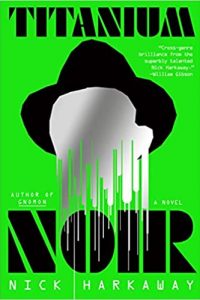Alvaro Zinos-Amaro Reviews Hidden Wyndham: Life, Love, Letters Amy Binns
 Hidden Wyndham: Life, Love, Letters, Amy Binns (Grace Judson Press 978-0992756710, $14.95, 304pp, pb) October 2019.
Hidden Wyndham: Life, Love, Letters, Amy Binns (Grace Judson Press 978-0992756710, $14.95, 304pp, pb) October 2019.
In the Preface to his biography of Somerset Maugham, who was notoriously uncooperative with biographers, Ted Morgan recounts how Maugham directed his executors to prevent the publication of his letters. “Maugham,” writes Morgan, “who had spent most of his long life prying into the affairs of humankind, did not want his own affairs pried into.” John Wyndham appears to have similarly cloaked his life. Like Maugham, Wyndham discouraged biographers, and, when pressed during interviews, divulged only dribs and drabs of autobiographical information. He disliked having his picture taken, so much so that his author photo on books wasn’t updated for decades. Wyndham published dozens of stories in the leading genre magazines of his day, and wrote science fiction novels that sold by the millions – The Day of the Triffids (1951), The Kraken Wakes (1953), The Chrysalids (1955), and The Midwich Cuckoos (1957) – several of which were adapted for film, radio, television, and comic books. Despite all the public attention, little was known about his personal life. He kept even his closest friends at a remove from affairs of the heart. Indeed, when he announced his marriage to his long-term partner Grace Wilson, his inner circle was stunned to learn that he’d even had a girlfriend. Given this aloofness and reticence to public exposure, it is perhaps not surprising that until now such an influential and visionary science fiction writer has not been the subject of a full biography. I’m therefore most grateful to Amy Binns who, with her well-researched and engaging treatment, has filled in a prominent gap in our genre history.
Her book’s title alludes both to Wyndham’s nature – his colleagues and fans “didn’t really know him, whether they realized it or not,” notes Binns – and to our path into his interiority, namely his extensive correspondence with Grace Wilson. Binns does a commendable job of walking us through Wyndham’s early days in a fractured family whose father would eventually alienate himself from everyone else; Wyndham’s unconventional education at the progressive Bedales School; his early forays into fiction (between 1927 and 1935 he published three mystery novels); his involvement in WWII, domestically as a censor, and then abroad with the British Army, including a series of experiences that scarred him and informed much of his dystopian fiction; his long-time residence at the Penn Club; his breaking out, after much rejection, into commercial success with the now-classic The Day of the Triffids; and his latter years with Grace, which outwardly mimicked a conventional domestic arrangement but still hinged on significant personal compartmentalization.
Binns’s fascination with Wyndham, and the genesis of this project, was sparked by Wyndham’s heroines. “Re-reading his novels many years after I first picked them up,” writes Binns, “I realized the narrator’s other half was the same character over and over. She is so finely drawn, I felt sure she was based on a real person.” In the chapter titled “Wyndham’s Women” Binns details these characteristics and ties them back to Grace Wilson. She also offers close readings of mature Wyndham stories with strong female characters, such as “Consider Her Ways”, which merit the attention of contemporary readers. Other chapters illustrate the importance of H.G. Wells to Wyndham’s development as a writer, an aesthetic sensitivity and literary ambition that made him a less-than-ideal purveyor of slam-bang pulp stories in the ’30s (though he did write his share, many under the name of John Beynon), and the key themes to which he returned obsessively: notably “evolution, and the hive mind, the evolutionary advantage of insects’ ability to think and act as a group,” as well as the notion of “children as the true aliens.” We also learn about Wyndham’s insecurities regarding his writing (“nothing happens” was a recurring worry), which help to humanize him, and about his connections with other writers. Was Ira Levin’s The Boys from Brazil (1976) inspired by an early version of Wyndham’s Plan for Chaos (2009), which Levin might have learned of via Fred Pohl? Did Wyndham and George Orwell ever meet? Binns proves a knowing literary guide throughout, deftly highlighting commonalities between various stories and novels, and candidly assessing some works’ shortcomings.
The core of her chronicle is the war-time letters (now held in the University of Liverpool archive) penned by Wyndham – who went by Jack in his everyday life – to Grace, and it’s the inclusion of these documents, along with a wonderfully curated selection of rare photographs, that really bring the man to life. “Reading them is an extraordinary experience,” says Binn, and so it is. Letter after letter illuminates the deeply affective and humane consciousness of a man who longed to be reunited with his partner and confidante, and yet felt profoundly rattled by his own war-time actions. Binns’s epistolary selections are thoroughly revealing, engrossing, often charming, and quite moving. At times I found myself wondering if Wyndham’s ghost would be dismayed by this posthumous invasion of his privacy – and then I turned the page and read on.
Perhaps because so much of Wyndham’s own writing is featured, Binns’s own prose at times suffers by comparison. I found her choice of an introductory dramatizing Prologue ill-advised. Some turns of phrase – e.g. “Theirs was never a match made in heaven” – evoke melodrama, and she occasionally falls into repetitive patterns of expression (e.g. “Now he was part of an invading force, seeing daily bodies of the men he had helped to kill. […] Now he was a part of that destructive force and he feared he was permanently tainted.”) On the whole, her sources are clearly documented, and intriguing comments are often elaborated on at the end of each chapter, but there were a few cases where I couldn’t find a citation, as for instance when she quotes Edmund Crispin’s description of Wyndham’s writing.
Peter Nicholls concludes his Science Fiction Encyclopedia article on the scholar David Ketterer, whose work Binns frequently references, with these words: “In the early twenty-first century, he [Ketterer] has been working on the life and work of John Wyndham, also a figure who has perplexed many; the full study is awaited with impatience.” Though whatever Ketterer adds to this conversation in the future will no doubt be interesting, Nicholls’s wait is now over. Indeed, we can only hope that Binns’s highly readable biography – which, besides all else, engages with the 2005 BBC documentary “John Wyndham: The Invisible Man of Science Fiction” – paves the way for future studies. Indeed, she herself mentions a forthcoming, admittedly niche, book on guided walks by Neil Pollard, titled In John Wyndham’s Footsteps. Wyndham, who was elected president of the 1957 World Science Fiction Convention held in London, “doesn’t feature in anecdotes or memories,” though he does appear in a couple of photographs. (I asked Robert Silverberg, featured in a picture with Wyndham, about his interactions with Wyndham during that long-ago convention, and he recalled only “one brief conversation” with him). “He is briefly evident when required to take part in proceedings,” observes Binns, “then melts away, not even into the background, but into invisibility.” Hidden Wyndham unveils the invisible man for us, projecting a most deserved, and long overdue, spotlight on this enigmatic and enthralling artist.
This review and more like it in the February 2020 issue of Locus.
 While you are here, please take a moment to support Locus with a one-time or recurring donation. We rely on reader donations to keep the magazine and site going, and would like to keep the site paywall free, but WE NEED YOUR FINANCIAL SUPPORT to continue quality coverage of the science fiction and fantasy field.
While you are here, please take a moment to support Locus with a one-time or recurring donation. We rely on reader donations to keep the magazine and site going, and would like to keep the site paywall free, but WE NEED YOUR FINANCIAL SUPPORT to continue quality coverage of the science fiction and fantasy field.







